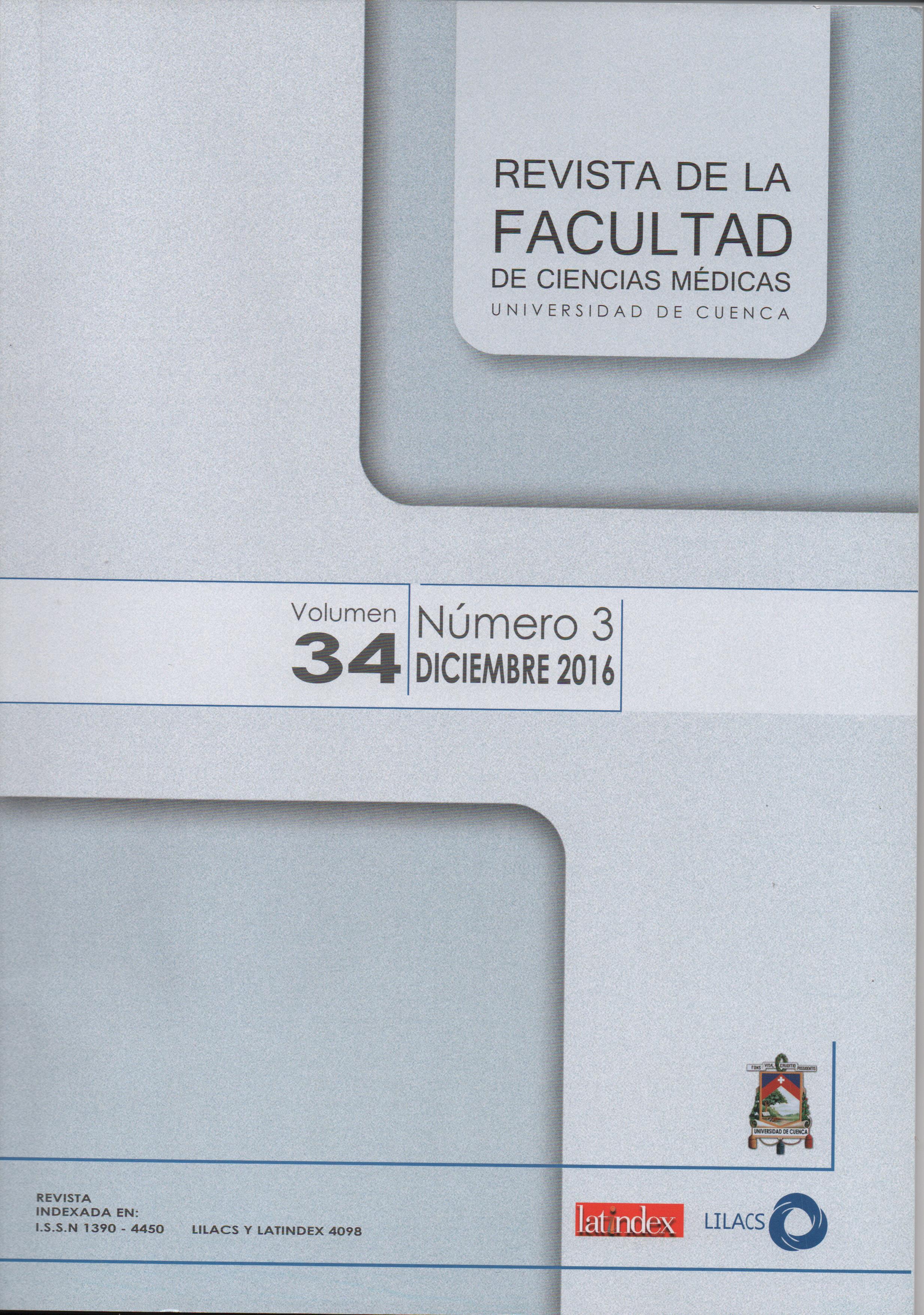VALOR DIAGNÓSTICO DE LA TÉCNICA DEL BLOQUE CELULAR FRENTE A LA CITOLOGÍA CONVENCIONAL EN FLUIDOS CORPORALES SOLCA-CUENCA 2007- 2008.
Resumen
RESUMEN
El diagnóstico anatomo-patológico de las enfermedades neoplásicas se realiza a través del estudio morfológico, ya sea por métodos citológicos o histopatológicos, complementados en casos necesarios, por otros procedimientos o técnicas adicionales. La diferenciación citológica entre células benignas y malignas en fluidos serosos y en biopsias por aspiración con aguja fina, es frecuentemente difícil en la práctica diaria. La técnica del bloque celular es importante para poder revelar células tumorales en muestras que han sido reportadas como negativas para malignidad por los métodos citológicos convencionales, pues es una metodología que permite la utilización de la inmunohistoquímica.
OBJETIVO: Análisis del valor diagnóstico de la técnica de bloque celular en fluidos corporales patológicos y de biopsias por aspiración con aguja fina, en el Departamento de Patología del Instituto del Cáncer SOLCA-Cuenca. Período junio 2007- marzo 2008.
MÉTODOS: Estudio de tipo descriptivo correlacional entre citología convencional y bloque celular. Se incluyeron 56 casos provenientes de líquidos de lavado peritoneal; líquido ascítico, pleural, intratumoral, biliar; BAAF de glándula mamaria, tiroides, ganglio, conducto vaginal tumor pancreático y de muestras fisiológicas como la orina; a los que se les realizó cito-centrifugación en el equipo de Cytospin y técnica de bloque celular.
RESULTADOS: Con la técnica de Cytospin hubo casos no concluyentes para diagnóstico, mientras que con la técnica de bloque celular (BC) no se presentaron. Con la técnica de bloque celular se encontró en un 28.5% de casos neoplásicos malignos y con la citología convencional, en un 10.7%. Al 30.5% se le solicitó técnicas de inmunohistoquímica para definir el origen neoplásico, siendo la mayoría procedentes del tracto gastrointestinal y pulmonar.
CONCLUSIONES: La técnica de bloque celular debe ser un procedimiento de rutina en la sección de citología. La utilidad de los bloques celulares se debe en parte a su sencillez, y por otro lado aporta especificidad, ya que permite valorar aspectos como la arquitectura de la muestra, y realizar técnicas de citoquímica e inmunohistoquímica y presentan una calidad óptima para su interpretación.
PALABRAS CLAVE: Biología Celular, Patología, Histocitoquímica, Técnicas y Procedimientos Diagnósticos, SOLCA-Cuenca.
ABSTRACT
Anatomy-pathological diagnosis of neoplastic diseases is performed through the morphological study, either by cytological or histopathological methods, which were supplemented in necessary cases by other procedures or additional techniques. The cytological differentiation beteen benign and malignant cells in serous fluids and in fine needle aspiration biopsies is often difficult in daily practice. The technique of the cell block is important to be able to reveal tumor cells in samples that have been reported as negative for malignancy by conventional cytological methods, since it is a methodology that allows the use of immunohistochemistry. OBJECTIVE: Analyze the diagnostic value of the cell block technique in pathological body fluids and fine needle aspiration biopsies in the Department of Pathology of the SOLCA-Cuenca Cancer Institute. Period June 2007 - March 2008.
METHODS: It is a descriptive correlational study between conventional cytology and cell block. A total of 56 cases from peritoneal lavage fluids ere included ascites fluid, pleural, intratumoral, biliary, AA of mammary gland, thyroid, ganglion, vaginal duct, pancreatic tumor and physiological samples such as urine; who were cyto-centrifuged in the Cytospin team and cell block technique.
RESULTS: With the Cytospin technique there were inconclusive cases for diagnosis, while with the cell block technique (CB) they were not present. The cell block technique was found in 28.5% of malignant neoplastic cases and with 10.7% in conventional cytology. The 30.5% were asked for immunohistochemical techniques to define the neoplastic origin, being the majority from the gastrointestinal and pulmonary tract.
CONCLUSIONS: The cell block technique should be a routine procedure in the cytology section. The usefulness of the cell blocks is due to its simplicity, and on the other hand it contributes specificity, since it allos evaluating aspects such as the architecture of the sample, and performs techniques of cytochemistry and immunohistochemistry presenting an optimal quality for its interpretation.
KEYWORDS: Cell Biology, Pathology, Histocytochemistry, Diagnostic Techniques and Procedures, SOLCA-Cuenca.Descargas
Descargas
Publicado
Número
Sección
Licencia
Copyright © Autors

Usted es libre de:
 |
Compartir — compartir y redistribuir el material publicado en cualquier medio o formato. |
 |
Adaptar — combinar, transformar y construir sobre el material para cualquier propósito, incluso comercialmente. |
Bajo las siguientes condiciones:
 |
Atribución — Debe otorgar el crédito correspondiente, proporcionar un enlace a la licencia e indicar si se realizaron cambios. Puede hacerlo de cualquier manera razonable, pero de ninguna manera que sugiera que el licenciador lo respalda a usted o a su uso. |
| No comercial — No puede utilizar el material con fines comerciales. | |
| Compartir Igual— si remezcla, transforma o desarrolla el material, debe distribuir sus contribuciones bajo la misma licencia que el original. |
| Sin restricciones adicionales: no puede aplicar términos legales o medidas tecnológicas que restrinjan legalmente a otros a hacer cualquier cosa que permita la licencia. |






